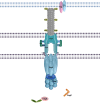Roles of the components of the cag-pathogenicity island encoded type IV secretion system in Helicobacter pylori
- PMID: 39171625
- PMCID: PMC11633423
- DOI: 10.1080/17460913.2024.2383514
Roles of the components of the cag-pathogenicity island encoded type IV secretion system in Helicobacter pylori
Abstract
The Helicobacter pylori (H. pylori) cytotoxin-associated gene pathogenicity island (cagPAI) encodes 31 genes that assemble the cag type IV secretion system (T4SS) apparatus, which includes structures such as the outer membrane core complex, periplasmic ring, inner membrane complex and bacterial hairs. These proteins interact with each other to inject CagA into the host gastric epithelium. There are also individual unique functions that help H. pylori interfere with host cellular pathways, modulate the immune response and colonize the host for a long time. However, the functions of some of the proteins remain unclear. This review summarizes what is known about the structure and function of these auxiliary components and discusses their role in H. pylori pathogenesis.
Keywords: Cag-T4SS; CagL; CagY; Helicobacter pylori; cagPAI.
Plain language summary
[Box: see text].
Conflict of interest statement
The authors have no competing interests or relevant affiliations with any organization or entity with the subject matter or materials discussed in the manuscript. This includes employment, consultancies, honoraria, stock ownership or options, expert testimony, grants or patents received or pending, or royalties.
Figures

Similar articles
-
Helicobacter pylori CagA and Cag type IV secretion system activity have key roles in triggering gastric transcriptional and proteomic alterations.Infect Immun. 2025 Apr 8;93(4):e0059524. doi: 10.1128/iai.00595-24. Epub 2025 Mar 6. Infect Immun. 2025. PMID: 40047510 Free PMC article.
-
Species-specific components of the Helicobacter pylori Cag type IV secretion system.Infect Immun. 2025 May 13;93(5):e0049324. doi: 10.1128/iai.00493-24. Epub 2025 Apr 10. Infect Immun. 2025. PMID: 40208031 Free PMC article.
-
CagY-Dependent Regulation of Type IV Secretion in Helicobacter pylori Is Associated with Alterations in Integrin Binding.mBio. 2018 May 15;9(3):e00717-18. doi: 10.1128/mBio.00717-18. mBio. 2018. PMID: 29764950 Free PMC article.
-
The type IV secretion system in Helicobacter pylori.Future Microbiol. 2018 Jul;13:1041-1054. doi: 10.2217/fmb-2018-0038. Epub 2018 Jun 21. Future Microbiol. 2018. PMID: 29927340 Review.
-
Composition, structure and function of the Helicobacter pylori cag pathogenicity island encoded type IV secretion system.Future Microbiol. 2015;10(6):955-65. doi: 10.2217/fmb.15.32. Future Microbiol. 2015. PMID: 26059619 Free PMC article. Review.
Cited by
-
Helicobacter pylori and gastric cancer: mechanisms and new perspectives.J Hematol Oncol. 2025 Jan 23;18(1):10. doi: 10.1186/s13045-024-01654-2. J Hematol Oncol. 2025. PMID: 39849657 Free PMC article. Review.
-
Helicobacter pylori-related serum indicators: Cutting-edge advances to enhance the efficacy of gastric cancer screening.World J Gastrointest Oncol. 2025 Mar 15;17(3):100739. doi: 10.4251/wjgo.v17.i3.100739. World J Gastrointest Oncol. 2025. PMID: 40092953 Free PMC article. Review.
-
Decoding the Ability of Helicobacter pylori to Evade Immune Recognition and Cause Disease.Cell Mol Gastroenterol Hepatol. 2025;19(5):101470. doi: 10.1016/j.jcmgh.2025.101470. Epub 2025 Jan 30. Cell Mol Gastroenterol Hepatol. 2025. PMID: 39889829 Free PMC article. Review.
References
Publication types
MeSH terms
Substances
Grants and funding
LinkOut - more resources
Full Text Sources
Medical
